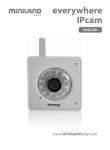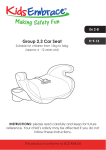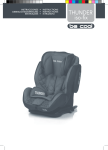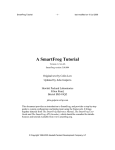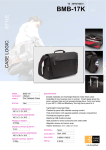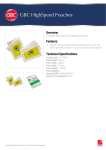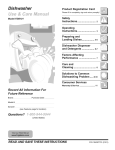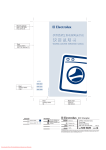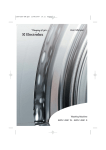Download My Child Echo (SAP) Instruction manual
Transcript
Echo (SAP*) Car Seat Group 1+2 child car seat *side armour protection This product conforms to ECE R44.04 Group 1+2 child car seat. Suitable for children from 9kg to 25kg (approx 9 months to 4 years old) Instructions: Please read carefully and keep for future reference. Your child’s safety may be affected if you do not follow these instructions. V1 Notices 1. The child car seat must only be used in vehicles which are fitted with a three point seatbelt system that has been approved by regulation ECE-16 or similar. 2. A correct fit is likely if the vehicle manufacturer has declared in the vehicle hand book that the vehicle is capable of accepting a ‘Universal ’child restraint for this group. 3. The child car seat is a ‘Universal’ child restraint; it conforms to regulation ECE-R44/04 for general use in vehicles. It will fit most, but not all vehicle seats. 4. This child car seat has been declared ‘Universal’ under more stringent conditions than those applied to earlier designs, which do not carry the ‘Universal’ mark. 5. Child car seats can mark vehicle seat upholstery. The manufacturer cannot be held responsible for damage or marking to vehicle seats. 6. The following situations could be illegal and will invalidate the warranty: 1) Any modifications or change of use of the child car seat that have not been authorised or advised by the manufacturer. 2) Any failure to fit the child car seat in strict accordance with the instructions. The manufacturer accepts no liability for issues arising from unauthorised modifications, uses or fitting. 7. Please keep this manual safe for any possible queries you may have in the future. 8. You will need to keep your proof of purchase. We recommend you keep them together. GETTING STARTED Read Carefully Before Attempting to Fit the Child Car Seat Warning: NEVER leave your child unattended – your child’s safety is your responsibility. Warning: The child car seat must be fitted in accordance with the manufacturer’s instructions. Incorrect installation could be dangerous. Warning: This installation must only be performed by a competent adult. Don’t try to install the seat when intoxicated or drowsy. Warning: Always ensure that new or occasional users [e.g. grandparents] have read the instructions or been taught the correct installation by someone who has read and understood the instructions. Warning: Always keep this instruction manual with the child car seat, or in the vehicle in which you are carrying the child car seat. Some models of child car seat have a pocket to store the instructions. Before Starting Attention: Do not carry the child car seat using the red seatbelt guides! This may damage or break them. Warning: Do not fit the child car seat on a side or rear facing vehicle seat. Warning: Before installing the child car seat ensure that the passenger seat you are using is locked in the upright position. Warning: Do not use the child car seat in the home - it has only been designed to be used in the car. Warning: Do not leave loose/unsecured objects on the back seat of your car or the parcel shelf. They may be dangerous to your child if you are forced to brake suddenly. Which is the safest passenger seat to fit your child car seat to? THE CENTRE REAR PASSENGER SEAT If your centre rear passenger seat is fitted with a three point seatbelt system then you should use it. If your centre rear passenger seat does not have a three point seatbelt system (i.e. no seatbelt at all, or only a lap belt) - then you should use the rear left passenger seat or the rear right passenger seat. The front passenger seat can only be used if it DOES NOT have an airbag and IS fitted with a three point seatbelt system. page 1 EXTREME HAZARD NEVER USE IN FRONT PASSENGER SEATS EQUIPPED WITH AIRBAGS (SRS) THIS CAN INCLUDE REAR PASSENGER SEATS THAT ARE EQUIPPED WITH AIRBAGS* *Consult car manufacturer for suitability. Children’s bodies are not able to withstand the forces exerted on them by a deploying air-bag When Using the Child Car Seat Warning: Make sure that the child car seat is placed somewhere so that rigid items and plastic parts do not become trapped in doors or movable seat units when the seat is in everyday use. Warning: Always use the vehicle’s door child safety lock system, if one is available, to make it impossible for the child to open the car doors from inside. Warning: Allow the child a break during long car journeys and make sure they don’t get out of the car unaided and without supervision. Warning: The child car seat must be fitted securely to the passenger seat. Ensure that it is not loose or wobbly after you have fitted it. If it is loose, re-fit it. Warning: Ensure that the child car seat is secured to the car seat at all times - even when not in use. Warning: The child car seat must not be used without its original cover. The original cover is essential for the safe operation of the child car seat. Warning: Stop the car at regular intervals to check that the child car seat is in the correct position and that both the car seatbelt AND the child car seat harness are still taut and latched. Warning: In the event of an emergency it is important to be able to release the child quickly (as defined by British Standards). This means that the seat buckle cannot be fully tamper proof and you should actively discourage your child from playing with or using the buckle. Warning: If you travel with passengers using both the front and the rear passenger seats, the lighter occupants should be in the rear and the heavier occupants in the front. Warning: If you have no option other than to put your child car seat on a rear passenger seat next to side airbags: - Consult with your vehicle manufacturer for side airbag details. It may not be safe. - Make sure your child does not lean into the area immediately around the airbag. Warning: Do not place anything under the child car seat (e.g. a towel or cushion) as this could affect the performance of the seat in an accident. Warning: Avoid winter clothing bundling - Bulky clothing can lead to incorrect harness tightening. In an accident, the child can slip right out of the extra padding - and thus out of the seat. Let the car warm up or cool down prior to placing your child in there if possible. If your child is cold, place a blanket over the top of the harness. Seatbelt Warning: NEVER use any load bearing contact points other than those described in these instructions or marked on the child car seat. Warning: Ensure that the lap section of the seatbelt or harness is worn low down, so that the pelvis is firmly engaged. Warning: Make sure that ALL the passengers in your vehicle have their seatbelts fastened, as unrestrained people can be very dangerous to the child in an accident. Warning: NEVER use a seatbelt routing scheme that differs from these instructions. Warning: The lap and diagonal seatbelt (and harness if fitted) must be used at all times when your child is in the child car seat. Warning: Make sure that there are no twists in the seatbelt. page 2 Sunlight/Hot days Warning: Don not leave your child in the child car seat while parked in direct sunlight or on a hot day. Warning: Do not subject the child car seat to prolonged direct sunlight as this may be dangerous for your child (the metal and plastic fittings could become hot) and may cause the fabric to fade. You can reduce this problem by covering the child car seat with a sheet when not in use. Back of the Seat/Headrest Warning: Ensure that the child car seat is as close as possible to the backrest of the car seat. Warning: REMOVE the headrest of the passenger seat being used if it obstructs the proper installation of the child car seat. REMEMBER to refit the headrest when the child car seat has been removed. Second Hand or Damaged Child Car Seats and Seatbelts Warning: Never buy a second hand child car seat. It may have unseen damage. Warning: The manufacturer only guarantees this product when the original owner uses it. Warning: You MUST replace the child car seat and your vehicles seatbelts if they becomes badly worn or damaged. Warning: You MUST replace the child car seat if it is involved in an accident – it may have unseen damage and may not protect your child as well as they should. At the very least send the child car seat to the manufacturers for inspection, together with the accident report. Your 3 year warranty Whilst we make and test our products to the highest standards of durability there’s always a small chance of a hiccup! Our promise is to repair, replace or refund a MyChild product that has an identified manufacturing defect from the date of purchase for a full 3 years thereafter at no extra cost. However, you must register within 28 days of the date of purchase to receive the full 3 years guarantee! To receive your full guarantee you can register your product by: visiting www.mychildonline.co.uk/warranty.html and complete the warranty form, or by telephone on 0161 335 2508. Contents Welcome Parts checklist Positioning the seat Five-position seat recline Installing for group I [9-18kg] Placing your child in the seat - group I [9-18kg] Adjusting the harness height Converting for children in group II [15-25kg] Installing for group II [15-25kg] Removing the seat cover Replacing the seat cover and harness Maintenance and cleaning page 3 4 4 5 5 5-7 8 9-11 12-14 15 15 16-19 19 Welcome Thank you for purchasing the Echo (SAP) child car seat. Please read these instructions carefully before use to ensure safe and satisfactory operation of this product. Your child’s safety is your responsibility. If you have a query with this product or require replacement parts, please contact your nearest MyChild retailer. Parts checklist 1 2 8 1 Diagonal seatbelt guide 9 2 Shell (front) 3 Side Armour Protection (SAP) 4 Installation sticker 5 Harness yoke 6 Lap belt guide 7 Base 8 Fabric cover 9 Installation bar and lock 10 Lock-off device 11 Instructions storage compartment 12 Lap belt guide 13 Shell (rear) 14 Head cushion 15 Harness shoulder pads 16 Buckle 17 Base cushion 18 Harness adjuster button 19 Harness adjuster strap 20 Shoulder strap height slots 21 Shoulder strap 22 Waist harness 23 Booster cushion insert 24 Crotch harness 25 Recline adjuster handle 10 3 4 11 5 12 6 13 7 20 14 15 21 16 22 17 23 18 24 25 19 page 4 Positioning the seat A The child car seat can only be used with an automatic 3-point safety belt (A) and NOT with a 2-point lap belt (B). B The child car seat can be secured in a forward-facing position in the rear seats of the vehicle by using the existing seatbelts. However, on some seats, if the installation is not properly secured, we suggest you try another seat in your vehicle. Although not recommended, the child car seat can be used on a passenger side front seat, so long as there is no active airbag. WARNING: Never use in a seat with an active airbag. Five-position seat recline seated The child car seat can be used in five different seat positions, from seated to a reclined sleeping position. Pull the recline adjuster handle under the front of the shell and whilst holding it, pull the shell forwards or backwards, release the handle on your required position when hearing a distinct click. reclined Installing for Group I [9-18kg] Place the child car seat on a suitable passenger seat. Adjust the child car seat to its most reclined position. Pull the recline adjuster handle under the front of the shell and whilst holding it, pull the shell forwards to its most reclined position. page 5 Installing for Group I [9-18kg] (continued) B A Pull up lock (A) on the top right hand side of the shell and pull out the installation bar (B) on the opposite side. Tilt the seat shell forwards, feed the seatbelt between the seat and the base and plug the buckle in ensuring the seatbelt is not twisted. Push the child car seat back into the passenger seat ensuring a good fit. D Thread the horizontal lap belt section under both hooks (C) and remove all the slack by pulling up on the diagonal section of seatbelt. Thread the diagonal section through the lock off device (D) that is nearest to the seatbelt. C E F G H To operate the lock-off device: Pull down on tab (E) to open the locking device. Lift up the latch (F). Pass the seatbelt under the latch and pull the belt tight (G). Close the latch and fasten the tab (H) whilst holding the diagonal section of seatbelt tight. page 6 Installing for Group I [9-18kg] (continued) I K J Return the shell to its original position (I) taking care not to trap the diagonal shoulder belt and thread the installation bar back through the seat (J). Secure the lock on the top right hand side of the child car seat (K). Pull the installation bar to ensure it is securely locked in place. NOTE: If you are having difficulty replacing the installation bar - first ensure the diagonal seatbelt is not in the way, then jiggle the installation bar to help work it through the shell. With your child car seat now buckled in, check it is secure by pulling forward from both harness straps, there should be little or no movement. Next check that the vehicle’s seatbelt buckle is NOT resting against the child car seat shell. This is called ‘buckle crunch’ and could cause the child car seat to work loose or the seatbelt to come undone in an accident. If you find you are experiencing ‘buckle crunch’ then this child car seat is not suitable for your vehicle. WARNING: The child car seat should always be strapped in using the vehicle’s seatbelt, whether a child is seated in the child car seat or not. page 7 Placing your child in the seat - Group I [9-18kg] Ensure that you have first installed the child car seat correctly, following the steps under ‘Installing for Group I [918kg]’, Press button (A) and unfasten the harness. A Press button (B) and pull up on the shoulder straps (not the shoulder pads) to loosen the straps. B IMPORTANT: DO NOT pull the shoulder pads. C D E F Place the harness straps over the side of the shell (C), position your child in the child car seat (D) ensuring no toys or other hard objects are in the seat. Match the two halves of the harness buckles together and insert them into the crotch buckle (E). Make sure the shoulder straps fit your child snugly by pulling the adjuster belt (F). page 8 Adjusting the harness height Attention: You should not attempt to adjust the harness height with a child in the child car seat. The harness strap slots should be level with or above your child’s shoulders. If they are not, then you may need to reposition the harness shoulder straps and adjust the harness height. Adjust the shell to its most reclined position. Pull the recline adjuster handle under the front of the shell and whilst holding it, pull the shell forwards to its most reclined position. Press button (A) and pull up on the shoulder straps (not the shoulder pads) to completely loosen the straps. Ensure you loosen the shoulder straps completely as this will aide the harness removal. IMPORTANT: DO NOT pull the shoulder pads. A page 9 Adjusting the harness height (continued) Remove the installation bar (B) by pulling the lock (C) up, on the top right hand side of the shell. B C Pull and hold the shell forward. Unhook the straps at the rear of the seat shell by sliding the straps through the slits in the shoulder pads connector (D) and yoke (E). D E NOTE: The thinner straps are the shoulder pad straps, and they connect to the shoulder pads connector (D) and the wider straps are the shoulder harness straps, and they connect to yoke (E). page 10 Adjusting the harness height (continued) F H G I J Adjust one side at a time. Pull one set of shoulder straps through their slot (F) and avoid twisting the straps. Pass both the wider strap (H) and narrow strap (I) back through the shell at your desired slot height (G),making sure the wider strap (H) is threaded through the shoulder pad (J), and that you keep the thinner strap (I) below the wider strap (H). Repeat on the opposite side. D N E M Check none of the straps are twisted and reconnect the shoulder pad straps to the shoulder pad connector (D) and the shoulder harness straps to the yoke (E). Return the shell to its original position and re-insert the installation bar (M) and secure lock (N). page 11 Converting for children in group II [15-25kg] It is recommended that you use the 5-point harness for as long as possible. Try removing the booster cushion as this could allow you to use the seat in group I configuration for longer. A B When your child has outgrown the group I (9-18kg) configuration or you wish to use the seat for a child 15-25kg, then you will need to convert the child car seat to group II mode. You will need to remove the child car seat’s integral 5-point harness. Press button (A) and pull up on the shoulder straps (not the shoulder pads) to completely loosen the shoulder straps and shorten the adjuster strap (B) as much as possible. IMPORTANT: DO NOT pull the shoulder pads. Adjust the shell to its most reclined position. Pull the recline adjuster handle under the front of the shell and whilst holding it, pull the shell forwards to its most reclined position. page 12 Converting for children in group II [15-25kg] (continued) Remove the installation bar (C) by pulling the lock (D) up, on the top right hand side of the shell. C D Pull and hold the shell forward. page 13 Converting for children in group II [15-25kg] (continued) Unhook the shoulder pad straps from shoulder pad connector (E). Unhook the shoulder harness straps from yoke (F). E G G Pass the shoulder straps through the slots in the back of the shell (G). F 1 2 I J H rear view of shell Locate the two metal retainer buckles (H) under the seat cover at points (1) and (2). Pass the metal buckles on the waist harness from the front of the shell, through the inner slots (I) on the back of the shell and back out the outer slots (J), to the front to remove the harness. If your child does not need the booster cushion (K) it can be removed. M L K To remove the crotch strap, ensure the child car seat is in a fully reclined position. Push the crotch strap down through the slot and hold it there, allowing the strap to slacken on the underside of the child car seat. Whilst holding the strap locate the metal retainer buckle underneath the car seat shell and pass it through the bottom of the seat and remove the crotch strap. Return the shell to its original position and re-insert the installation bar (L) and secure the lock (M). page 14 Installing for Group II [15-25kg] Ensure that you have first removed the child car seat’s integral 5-point harness, following the steps under ‘Removing the 5-point harness’, A C Position your child in the child car seat, place the diagonal section of the seatbelt through the diagonal seatbelt guide (A) and the waist belt across the child’s lap and through belt guide (B). Finally fasten the seatbelt buckle (C). B WARNING: The child car seat should always be buckled in and secured, whether a child is seated in it or not! Removing the seat cover The seat cover is a safety feature. Never use the child car seat with out its cover. D B C A C The seat covers can be removed for cleaning (see “Maintenance and cleaning” p18). You will need a Phillips screwdriver. If not already removed then remove the harness straps, crotch strap, head cushion and base cushion (see ‘Converting for children in group II [1525kg]’ pages 11-13). Turn the child car seat on its side and using a Phillips screwdriver, unscrew the two screws on each side of the shell holding the belt guides (A) in place. Put the belt guides and screws safely to one side for later. Remove the two small side covers (B) by grasping the elastic band and pulling each cover off. The main cover is held in place by a series of hooks (C) located on the back and underside of the shell. Unhook the cover’s elastic from the hooks. Work the cover from under the strap hooks (D) and remove. page 15 Replacing the seat cover and harness B A C Place the cover over the child car seat and stretch the elastic over the shell, taking care as you work the cover over and around the plastic parts. Once in place secure the cover on the hooks (A) located on the back and underside of the shell. Stretch the two side covers (B) back over the side panels. A C The belt guides have a narrow point (1) and a wider point (2). 2 1 Reattach the belt guides (C) ensuring they are put on correctly as shown. 2 1 Reattach the two screws on each side. Attention: Be careful to not over-tighten the screws as this could cause damage. Adjust the shell to its most reclined position. Pull the recline adjuster handle under the front of the shell and whilst holding it, pull the shell forwards to its most reclined position. page 16 Replacing the seat cover and harness (continued) Unlock the lock (D), remove the installation bar (E) and pull the top of the shell forwards to access the space behind the shell more easily. D E Take the two harness shoulder straps with the buckle clips and crotch strap and match the buckle tongue sections together and insert into the buckle. With the buckle connected you will have something similar to the illustration opposite. page 17 Replacing the seat cover and harness (continued) F 1 2 3 F G Insert waist strap retainer buckles (F) through the two slots (1) and (2) on the cover and out through the outer slots on the back of the shell then back through the inner slots. Insert crotch strap retainer buckle (G) through slot (3). 4 4 3 3 I Thread strap ends (3) through the shoulder pads (H). Thread strap ends (3) and (4) through slots (I) H H Connect the shoulder pad straps (4) to the shoulder pad connector (J), connect the shoulder harness straps (3) to the yoke (K). J 4 3 4 3 K page 18 Replacing the seat cover and harness (continued) Return the shell to its original position and re-insert the installation bar (L) and secure lock (M). M L Maintenance and cleaning Storage 1) Store this child car seat in a safe place when not in use. 2) DO NOT place heavy objects on top of it. 3) Always store the child car seat in a dry environment. 4) DO NOT store the child car seat near a direct heat source such as a radiator. Covers 1) The seat cover is easily removable and should be handwashed with a pH neutral soap and cold water. 2) Do not press, iron, dry clean, tumble dry or wring the covers. 3) Do not use solvents, caustic or abrasive cleaning materials. 4) Dry flat, away from direct heat and sunlight. 5) If the seat covers need to be replaced only use MyChild certified parts. They are the only ones that are guaranteed to have been safety tested and designed to fit this seat. Plastic/Metal Parts 1) Wipe clean using a mild soap and warm water. 2) You must not remove, dismantle or alter any part of the seat shell. 3) You must not oil or lubricate any part of the seat shell. Inspection 1) Check your child car seat regularly for wear and tear. 2) The child car seat may have a slight rattle when not in use, this is normal. If in any doubt, contact MyChild immediately. 3) Check the adjustable parts of your child seat at intervals of about 6 months to ensure it is still fits correctly for your growing child. page 19 [email protected] Imported by MyChild. M34 3QA www.mychildonline.co.uk Tel: 0161 335 2508
























